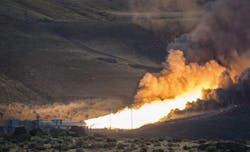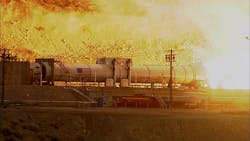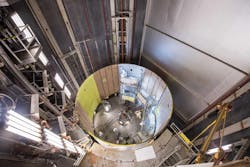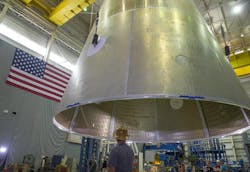NASA, Orbital ATK perform final Space Launch System booster system qualification test
PROMONTORY, Utah, 28 June 2016. A booster for NASA’s Space Launch System (SLS), designed to be the most powerful rocket in the world, fired up Tuesday for its second qualification ground test at Orbital ATK's test facilities in Promontory, Utah. A key milestone on the agency’s Journey to Mars, it is the last full-scale test for the booster before SLS’s first uncrewed test flight with NASA’s Orion spacecraft slated for late 2018.
The second and final qualification motor (QM-2) test for the Space Launch System’s booster is seen, Tuesday, June 28, 2016, at Orbital ATK Propulsion System's (SLS) test facilities in Promontory, Utah. During the SLS flight the boosters will provide more than 75 percent of the thrust needed to escape the gravitational pull of the Earth, the first step on NASA’s Journey to Mars. Credits: NASA/Bill Ingalls
“This final qualification test of the booster system shows real progress in the development of the Space Launch System,” says William Gerstenmaier, associate administrator for the Human Exploration and Operations Mission Directorate at NASA Headquarters in Washington. “Seeing this test today, and experiencing the sound and feel of approximately 3.6 million pounds of thrust, helps us appreciate the progress we’re making to advance human exploration and open new frontiers for science and technology missions in deep space.”
The booster was tested at a cold motor conditioning target of 40 degrees Fahrenheit -- the colder end of its accepted propellant temperature range. When ignited, temperatures inside the booster reached nearly 6,000 degrees. The two-minute, full-duration ground qualification test provided NASA with critical data on 82 qualification objectives that will support certification of the booster for flight. Engineers now will evaluate the data, captured by more than 530 instrumentation channels on the booster.
When completed, two five-segment boosters and four RS-25 main engines will power SLS on deep space missions. The solid rocket boosters, built by NASA contractor Orbital ATK, operate in parallel with SLS’s main engines for the first two minutes of flight. They will provide more than 75 percent of the thrust needed for the rocket and Orion spacecraft to escape Earth’s gravitational pull.
"Today's test is the pinnacle of years of hard work by the NASA team, Orbital ATK and commercial partners across the country," explains John Honeycutt, SLS Program manager at NASA’s Marshall Space Flight Center in Huntsville, Alabama. “SLS hardware is currently in production for every part of the rocket. NASA also is making progress every day on Orion and the ground systems to support a launch from Kennedy Space Center in Florida. We're on track to launch SLS on its first flight test with Orion and pave the way for a human presence in deep space."
Engineers are constructing qualification structural test articles for the core stage at NASA's Michoud Assembly Facility in New Orleans. Technicians at Michoud perform priming operations on the SLS engine section qualification test article. The primer is applied for corrosion protection. The hardware will be shipped later this year to the Marshall Center to undergo structural loads testing on a 50-foot test structure currently under construction. Credits: NASA/Michoud/Steven Seipel
The first full-scale booster qualification ground test was completed in March 2015 and demonstrated acceptable performance of the booster design at 90 degrees Fahrenheit – the highest end of the booster’s accepted propellant temperature range. Testing at the thermal extremes experienced by the booster on the launch pad is important to understand the effect of temperature on how the propellant burns.
The initial SLS configuration will have a minimum 70-metric-ton (77-ton) lift capability. The next planned upgrade of SLS will use a powerful exploration upper stage for more ambitious missions, with a 105-metric-ton (115-ton) lift capacity. In each configuration, SLS will continue to use the same core stage and four RS-25 engines.
A crane lifts the qualification test article of the launch vehicle stage adapter (LVSA) after final manufacturing on a 30-foot welding tool at the Marshall Center. The test version of the LVSA and other structural test articles for the upper part of the rocket will be tested later this year at Marshall to verify the integrity of the hardware and ensure it can withstand the forces it will experience during flight. Credits: NASA/MSFC/Emmett Given
You might also like:
Subscribe today to receive all the latest aerospace technology and engineering news, delivered directly to your e-mail inbox twice a week (Tuesdays and Thursdays). Sign upfor your free subscription to the Intelligent Inbox e-newsletter at http://www.intelligent-aerospace.com/subscribe.html.
Connect with Intelligent Aerospace on social media: Twitter (@IntelligentAero), LinkedIn,Google+, and Instagram.
Intelligent Aerospace
Global Aerospace Technology Network
Intelligent Aerospace, the global aerospace technology network, reports on the latest tools, technologies, and trends of vital importance to aerospace professionals involved in air traffic control, airport operations, satellites and space, and commercial and military avionics on fixed-wing, rotor-wing, and unmanned aircraft throughout the world. 
Courtney E. Howard | Chief Editor, Intelligent Aerospace
Courtney enjoys writing about all things high-tech in PennWell’s burgeoning Aerospace and Defense Group, which encompasses Intelligent Aerospace and Military & Aerospace Electronics. She’s also a self-proclaimed social-media maven, mil-aero nerd, and avid avionics and space geek. Connect with Courtney at [email protected], @coho on Twitter, on LinkedIn, and on Google+.





